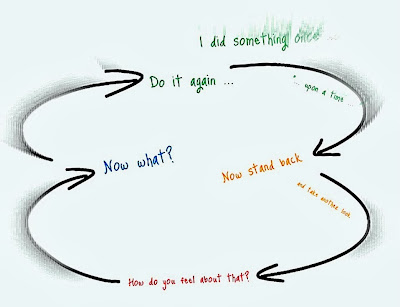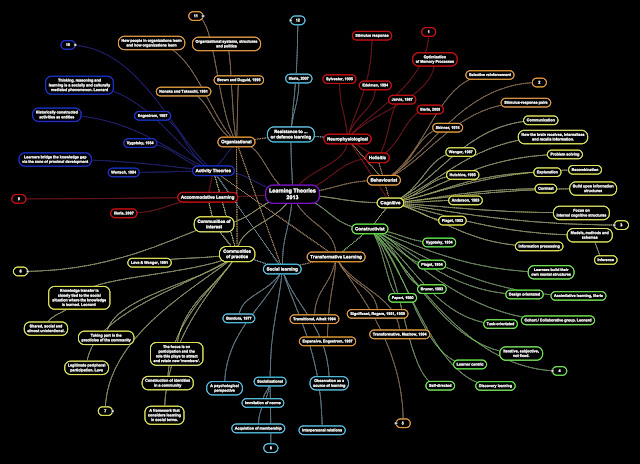H809 TMA 02 C
Learning is complex so creating.
All observations are theory impregnated. Popper, (1996:86)
Learning can broadly be defined as ‘any process that in living organisms leads to permanent capacity change and which is not solely due to biological maturation or ageing (Illeris 2007, p.3)
Learning involves both internal and external factors. (Conole and Oliver, 20xx)
Human learning is the combination of processes throughout a lifetime whereby the whole person - body (genetic, physical and biological) and mind (knowledge, skills, attitudes, values, emotions, beliefs and senses) - experiences social situations, the perceived content of which is then transformed cognitively, emotively or practically (or through any combination) and integrated into the individual person’s biography resulting in a continually changing (or more experienced) person.
(Illeris, in Contemporary Theories ... 2009)
There are many different kinds of learning theory. Each emphasizes different aspects of learning, and each is therefore useful for different purposes. (Conole and Oliver, ) What matters in learning and the nature of knowledge. And how families develop their own practices, routines, rituals, artifacts, symbols, conventions, stories and histories. (Conole and Oliver, )
Identify the key components of a number of theoretical approaches. Briefly introduce, say what it is and highlight key concepts.
How these might be applied to learning design with technology.
Clear RQs that are clearly derived from specific theories.
Recommend which data collection processes would be appropriate.
Conole et al (2004) x 7: Behaviourism, Cognitive, Constructivism, Activity-based, socially situated learning, experiential and systems theory.
Cube Representation of model. (Should be those things you roll) ADD OLDS MOOC and/or H817open
Mayes and de Frietas (2004) x3 Associative (structured tasks), cognitive (understanding) and situative.
Beetham (2005) x4: Associative, cognitive constructivist, social constructivist, situative.
See x4 Learning Theories Mind Map
Edudemic (2013) x 4 behaviourist, cognitive, constructive and connectivism
Traditional Learning Theories
http://edudemic.com/2012/12/a-simple-guide-to-4-complex-learning-theories/
Etienne Wenger (2007 in Knud Illeris) x9: organizational, neurophysiological, behaviourist, cognitive, activity theories, communities of practice, social learning, socialisational, constructivist.
Community of Practice and Community of Interests
‘Practitioners and overwhelmed by the plethora of choices and may lack the necessary skills to make informed choices about how to use these theories’. (Conole and Oliver 20xx)
|
|
|
|
|
Behaviourism
|
A perspective on learning (Skinner, 1950) reinforce/diminish. Stimulus/response. Aristotle. Hume. Pavlov. Ebbinghaus.
|
|
|
Cognitivism
|
Kant, Gagne, Rumlehart & Newman.
|
|
|
Activity Theory
|
Builds on the work of Vygotsky (1986). Learning as a social activity. All human action is mediated through using tools. In the context of a community. Knotworking. Runaway object.
|
Useful for analysing why problems have occurred - discordance. See Greenhow and Belbas for RQs.
|
|
Constructivism
|
Engestrom, Soctrates, Brown, Bruner, Illich,
|
|
|
Connectivism
|
Bush, Wells, Berners-Lee.
|
|
|
Humanism
|
Leonard (500 Theories)
|
|
Learning Theories from Wenger and others applied to OLDS MOOC
Organizational, Neurophsiological, Behaviourist, Cogntive, Resistence to or defence learning, activity theory, communities of practice, accommodation learning, social learning, transformative learning, socializational, constructivist.
Conole x6 pairings diagram
RESEARCH QUESTIONS
Formulate clear questions.
Amplification (Cole and Griffin) Amplifying as an increase in output - give a hunter a gun and they kill more prey. Give someone a computer and they write and calculate more. ‘Technology is best understood not as a static influence on literacy practice, but as a dynamic contributor to it’.
Learning and teaching: Behaviourism x3, cognitive theories x10 (including constructivism), humanisitc approaches, and others.
RQ
Quality not quantity
How these depend on the theoretical approach.
Strengths and Limitations
S - Situation, interactions, mechanisms can be more or less collaborative (Dillenbourg, 1999:9). Knowledge always undergoes construction and transformation in use. Learning is an integral aspect of activity. (Conole and Oliver, 2005). Communication is learning.
W - Across cultures, not just US and West. Caricatures/simplistic. Not a neat narrative.
O - Donations, Funding, Book promotion (MIT). The learner as a unique person.
T - Funding
REFERENCE
Conole (2007)
Conole, G; and Oliver, M. (eds) (20xx) Contemporary Perspective in E-learning Research. Themes, methods and impact on practice.
Crook, C and Dymott, R (20xx) ICT and the literacy practices of student writing. a
Edudemic. Traditional Learning Theories. (Accessed 19th April 2013)
http://edudemic.com/2012/12/a-simple-guide-to-4-complex-learning-theories/
Greenhow, C and Belbas, B (20xx:374)




.jpg) A new edition of the ‘dictionary’ of mental illnesses was published this year – the catchily named, DSM 5 (Diagnostic and Statistical Manual of the American Psychiatric Association, fifth edition). Compared to its predecessors, it classifies many more types of behaviour as ‘mental disorders’.
A new edition of the ‘dictionary’ of mental illnesses was published this year – the catchily named, DSM 5 (Diagnostic and Statistical Manual of the American Psychiatric Association, fifth edition). Compared to its predecessors, it classifies many more types of behaviour as ‘mental disorders’.
